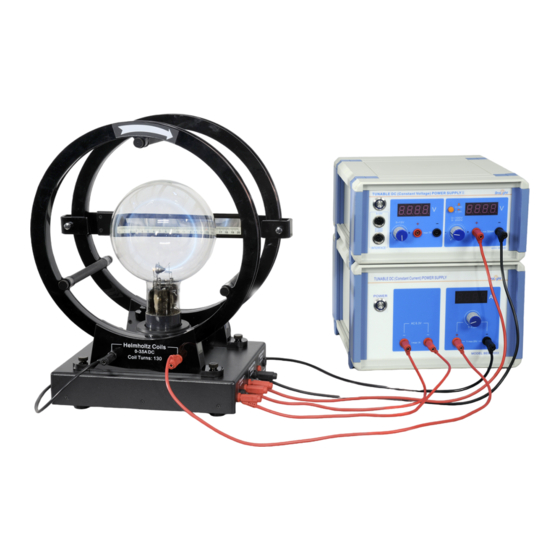Table of Contents
Advertisement
Quick Links
Electron Charge-to-Mass Ratio
Introduction
The e/m apparatus (Electron Charge-to-Mass Ratio) provides a
simple method for measuring e/m, the charge to mass ratio of
the electron. The method is similar to that used by J.J. Thomson
in 1897. A beam of electrons is accelerated through a known
potential, so the velocity of the electrons is known. A pair of
Helmholtz coils produces a uniform and measurable magnetic
field at right angles to the electron beam. This magnetic field
deflects the electron beam in a circular path.
The e/m apparatus also has deflection plates that can be used
to demonstrate the effect of an electric field on the electron
beam. This can be used as a confirmation of the negative
charge of the electron, as well as to demonstrate how an
oscilloscope works.
A unique feature of the e/m tube is that the socket rotates,
allowing the electron beam to be oriented at any angle (in the
range of ±30 degrees) with respect to the magnetic field from
the Helmholtz coils. You can therefore rotate the tube and
examine the vector nature of the magnetic forces on moving
charged particles.
What's included
• e/m Tube (SE-9651A)
• Helmholtz Coils and Base (SE-9626)
• Tunable DC Power Supply (Constant Current) (SE-9622)
• Tunable DC Power Supply II (Constant Voltage) (SE-9644)
Background information
In 1887, J.J. Thomson showed that the mysterious cathode rays
were actually negatively charged particles, thereby discovering
the electron. In the same year, he measured the specific charge
(e/m) of the cathode ray particles, providing the first
measurement of one of the fundamental constants of the
universe. The specific charge is defined as the charge per unit
mass of the particle. Thomson discovered that the value of e/m
was independent of the gas used, as well as independent of the
nature of the electrodes.
Principle of the experiment
In the e/m tube, the electrons move along a circular path in a
uniform magnetic field. The tube contains helium gas at a
precisely set pressure. The gas atoms are ionized along the
length of the circular path due to collisions with electrons. As a
result, they are excited and emit light, thereby indirectly making
the circular path of the electrons visible. The radius of the path
can then be measured directly with a ruler. Since the magnetic
field B and the accelerating voltage U of the electron gun are
known, it is possible to calculate the specific charge e/m of an
electron from the radius r of the circular path.
An electron moving with velocity v in a direction perpendicular to
a uniform magnetic field B experiences a Lorentz force F in a
direction perpendicular to both the velocity and the magnetic
field:
where e is the charge on an electron. This gives rise to a
centripetal force on the electron in a circular path with radius r,
as given by:
where m is the mass of an electron. Thus:
The velocity v depends on the accelerating voltage U of the
electron gun, as given by:
Therefore, the specific charge of an electron is given by:
If we measure the radius of the circular orbit in each case for
different accelerating voltages U and different magnetic fields B,
then, according to the equation, the measured values can be
2
2
plotted in a graph of B
r
versus 2U as a straight line through the
origin, with slope e/m.
Product Guide | 012-14265D
(SE-9629)
1
Advertisement
Table of Contents

Summary of Contents for PASCO SE-9629
- Page 1 Product Guide | 012-14265D Electron Charge-to-Mass Ratio (SE-9629) Introduction Principle of the experiment The e/m apparatus (Electron Charge-to-Mass Ratio) provides a In the e/m tube, the electrons move along a circular path in a simple method for measuring e/m, the charge to mass ratio of uniform magnetic field.
- Page 2 Electron Charge-to-Mass Ratio | SE-9629 Safety information Assembly Assemble the base WARNING: To avoid possible electric shock or personal injury, follow these guidelines. 1. Use the screws from the mounting hardware to fasten the two Helmholtz coils on the platform so that the terminals on •...
- Page 3 Product Guide | 012-14265D Connect cables and cords DANGER: High voltage is applied to the e/m tube. Avoid contact with any part of the body. • Only use shrouded patch cords for connections. • Make sure that the power supplies are OFF before making the connections.
- Page 4 Electron Charge-to-Mass Ratio | SE-9629 current passes through both of the coils in the same Analysis of e/m measurements direction. The magnetic field B generated in a pair of Helmholtz coils is - If the electron beam deflects downward, swap the proportional to the current I passing through a single coil.
- Page 5 (250 V T2A). One spare fuse is included inside the tray. 4. Reconnect the power cord and turn on the instrument. Specifications and accessories Visit the product page at pasco.com/product/SE-9629 to view the specifications and explore accessories. You can also download support documents from the product page.














Need help?
Do you have a question about the SE-9629 and is the answer not in the manual?
Questions and answers